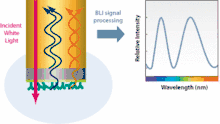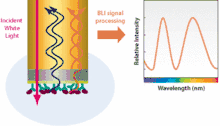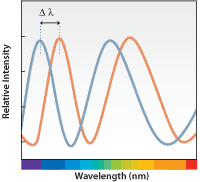Bio-layer interferometry
Bio-layer interferometry (BLI) is a label-free technology for measuring biomolecular interactions.[1][2] It is an optical analytical technique that analyzes the interference pattern of white light reflected from two surfaces: a layer of immobilized protein on the biosensor tip, and an internal reference layer (Figure 1). Any change in the number of molecules bound to the biosensor tip causes a shift in the interference pattern that can be measured in real-time (Figures 1 and 2).



The binding between a ligand immobilized on the biosensor tip surface and an analyte in solution produces an increase in optical thickness at the biosensor tip, which results in a wavelength shift, Δλ (Figure 3), which is a direct measure of the change in thickness of the biological layer. Interactions are measured in real time, providing the ability to monitor binding specificity, rates of association and dissociation, or concentration, with high precision and accuracy.
Only molecules binding to or dissociating from the biosensor can shift the interference pattern and generate a response profile. Unbound molecules, changes in the refractive index of the surrounding medium, or changes in flow rate do not affect the interference pattern. This is a unique characteristic of bio-layer interferometry and extends its capability to perform in crude samples used in applications for protein-protein interactions,[3] quantitation, affinity,[4] and kinetics.[5]
Bio-layer interferometry was pioneered by the founders of ForteBio, an instrument manufacturer based in Fremont, California. From 2018 to 2020, ForteBio was part of Molecular Devices.[6] In April 2020, ForteBio was acquired by Sartorius.[7]
References
- Cooper, Matthew (May 7, 2006). "Current biosensor technologies in drug discovery". Drug Discovery World (Summer): 68–82.
- Rich, Rebecca L; Myszka, David G (1 February 2007). "Higher-throughput, label-free, real-time molecular interaction analysis". Analytical Biochemistry. 361 (1): 1–6. doi:10.1016/j.ab.2006.10.040. PMID 17145039.
- Fang, Ye (20 November 2006). "Label-Free Cell-Based Assays with Optical Biosensors in Drug Discovery". Assay and Drug Development Technologies. 4 (5): 583–595. doi:10.1089/adt.2006.4.583. PMID 17115929.
- Fransson, Johan; Teplyakov, Alexey; Raghunathan, Gopalan; Chi, Ellen; Cordier, Wendy; Dinh, Thai; Feng, Yiqing; Giles-Komar, Jill; Gilliland, Gary; Lollo, Bridget; Malia, Thomas J; Nishioka, Walter; Obmolova, Galina; Zhao, Shanrong; Zhao, Yonghong; Swanson, Ronald V; Almagro, Juan C (30 April 2010). "Human Framework Adaptation of a Mouse Anti-Human IL-13 Antibody". Journal of Molecular Biology. 398 (2): 214–231. doi:10.1016/j.jmb.2010.03.004. PMID 20226193.
- Abdiche, Yasmina; Malashock, Dan; Pinkerton, Alanna; Pons, Jaume (15 June 2008). "Determining kinetics and affinities of protein interactions using a parallel real-time label-free biosensor, the Octet". Analytical Biochemistry. 377 (2): 209–217. doi:10.1016/j.ab.2008.03.035. PMID 18405656.
- "Molecular Devices announces brand identity for its newly-formed biologics business unit". www.fortebio.com. Retrieved 24 November 2018.
- "News Releases | ForteBio". www.fortebio.com. Retrieved 2020-06-08.